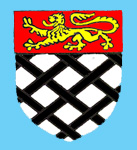The Manor of Meppershall

The Meppershall coat of arms
Volume II of The Victoria County History for Bedfordshire was published in 1908. The work gave detailed histories of every manor in the county. The Domesday Book of 1086tells us that the parish, then split between Bedfordshire (3 hides) and Hertfordshire (3 hides 1 virgate), had transferred from being held by Young Leofwin, a thane of King Edward, to Gilbert, son of Salaman.
The next reference to Meppershall is in the reign of Henry the II, when Robert son of William de Meppershall presented the advowson of the church of Meppershall to the priory of Lenton. The manor continued for nearly 300 years in the possession of the Meppershalls, who derived their family name from it, passing from father to son without a break in the line of succession.
In 1453, the manor was inherited by John of Meppershall's only daughter, Joan. Joan married John Butler, and the estate then passed to their son, John Butler, in 1460, thus removing the Meppershall family name from the estate. Upon John's death in 1482, the estate was divided between his two daughters, Joan and Florence. It is not known what happened to Florence, but the whole estate is later found in the sole possession of Joan Butler. Joan married twice. First to John Leventhorpe junior, and second to John Stanford. On her death in 1489, the manor passed to her surviving husband Stanford, 'for his life as tenant by courtesy'. On his death, it then passed to Joan's heir and son by her first husband, Thomas Leventhorpe.

The Leventhorpe coat of arms
The manor then passes down the Leventhorpe line until Thomas' great-grandson, also Thomas, died in 1620. As his only issue was his four year old daughter Elizabeth, the estate was taken into the Court of Wards and Liveries. Although Elizabeth obtained the livery of the manor in 1633 when she came of age, The Victoria County History explains that the history of the manor from this point becomes 'obscure'. It is suggested that Elizabeth died without issue as her aunts and uncles convey the manor to a Richard Emery in 1651.
When Richard Emery died, the manor passed to his two daughters, Elizabeth and Sarah, both spinsters. After both sisters had died in 1697 it passed to their aunt Frances Watson. Then, between 1744 and 1745 the manor was sold by Henry and Elizabeth Birrell and Thomas and Charlotte Fulwood to Bartlett Mason. It is suggested that Elizabeth and Charlotte may be the daughters of Frances Watson.
There is then another period of uncertainty, after which the manor is found in the possession of Thomas Poynter in 1805, whose family are believed to have purchased it 33 years previously from the Fulwoods. Thomas left two daughters, Barbara and Pen, and it was in the hands of their trustees that the manor was found when The Victoria County History was compiled. A succession of Law of Property Acts in the 1920s abolished manorial fines and incidents as well as copyhold land tenure, thus abolishing manors in practically all but name.